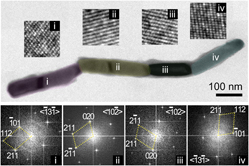Published online by Cambridge University Press: 29 July 2011

The size dependence of the lattice parameter of nanosolids has extensively been studied because lattice strain engineering is important in controlling the physical properties of nanowires (NWs), such as band gap, carrier transport, mechanical strength, etc. We have investigated the size-dependent lattice behavior of microstructure-controlled Sn NWs with radii of 7–35 nm. The NW microstructures were controlled as single-crystal, granular, and bamboo structures in the longitudinal direction. Results showed that the a-axis lattice parameter in the [100]-longitudinal direction of NWs can be controlled within 1% by varying the wire microstructure for the same wire radius because it is strongly dependent on the microstructure and the wire radius. Moreover, as the randomness of the grain orientation in the microstructure-controlled NWs increases, by which the anisotropy of surface stress is effectively reduced, the lattice strain of the NW can be compressive or tensile as a function of the wire radius. The longitudinal lattice parameters of microstructure-controlled Sn NWs can be tailored by reducing the effective anisotropy of surface stresses under a dimension confinement in the nanometer scale.